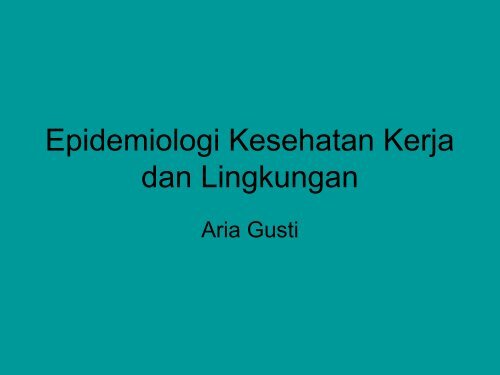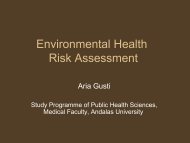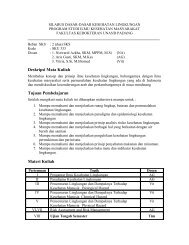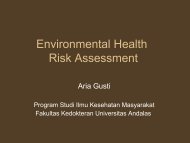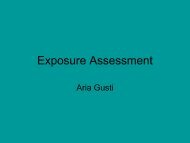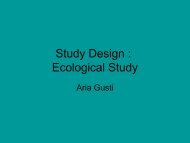Pengantar Epidemiologi Kesehatan Kerja dan Lingkungan
Pengantar Epidemiologi Kesehatan Kerja dan Lingkungan
Pengantar Epidemiologi Kesehatan Kerja dan Lingkungan
Create successful ePaper yourself
Turn your PDF publications into a flip-book with our unique Google optimized e-Paper software.
<strong>Epidemiologi</strong> <strong>Kesehatan</strong> <strong>Kerja</strong><strong>dan</strong> <strong>Lingkungan</strong>Aria Gusti
Learning Objective• The student should be able to discuss exposureassessment that are relevant to assessingenvironmental or occupational hazards inepidemiology.• The student should be able to explain thestrengths and limitations of epidemiologicalstudy designs for evaluating environmental oroccupational hazards.• The student should be able to identify studydesigns that are especially relevant tostudying environmental or occupationalhazards, and explain the rationale for thesestudy designs
Environmental Health“Whoever wishes to investigate medicineproperly should proceed thus: When hecomes into a strange city, he ought toconsider its situation, how it lies to the win<strong>dan</strong>d the sun, and consider the waters thepeople use. For if he knows these thingswell, he cannot miss knowing the diseasespeculiar to the place." Hippocrates (340B.C.)
Definition: ‘Environment’• ‘…[Segala] segala sesuatu yang diluardiri manusia sebagai host. [Itu] dapatdipilah menjadi lingkungan fisika,biologi, sosial budaya dimana sebagianatau seluruhnya dapat mempengaruhistatus kesehatan di dalam populasi.’(WHO, 1995)
Definition: Environmental Epidemiology• “Ilmu yang mempelajari efek dari faktorfisika, biologi <strong>dan</strong> kimia di lingkunganeksternal terhadap kesehatan manusia,dalam artian luas.• Dengan menguji secara spesifik populasiatau komunitas terpapar dengan lingkunganambien berbeda, adalah upaya untukmempertegas hubungan antara faktor fisika,kimia <strong>dan</strong> biologi dengan kesehatanmanusia”. National Research Council, USA (1991)
Definition: Environmental Epidemiology• “adalah studi atau cabang keilmuan yangmempelajari faktor-faktor lingkungan yangmempengaruhi timbulnya kejadian suatupenyakit, dengan cara mempelajari <strong>dan</strong>mengukur dinamika hubungan interaktif antarapenduduk dengan lingkungan yang memilikipotensi bahaya pada suatu waktu <strong>dan</strong> kawasantertentu, untuk upaya promotif lainnya (Achmadi,1991).
Individual Risk and Population Rate• Individual:DoseResponseRisk: likelihoodof effect in theindividual basedon the dose• Population:ExposureResponseRisk: proportionof persons withoutcome basedon the exposure
<strong>Epidemiologi</strong> <strong>Lingkungan</strong>A. Features and Challenges
Classic Environmental EpidemiologyStudies• Cholera in London and its relationship towater supply location for differenthouseholds (Snow, 1854)• Nuclear bombs at Hiroshima andNagasaki - studies of radiation effectsamong bomb survivors• Severe air pollution in London led to aepidemic of deaths from heart and lungdisease (1952)
Classic Environmental EpidemiologyStudiesWater SupplyNumber ofHouseCholeraDeadthsDeaths per10.000 houseSouthwark &Vauxhall Co40.046 1.263 315Lambeth & co 26.107 98 37Rest ofLondon256.423 1.422 59
Classic Environmental EpidemiologyStudies• "Minamata disease” – mengkonsumsiikan yang terkontaminasi dengan methylmercury• "Itai-Itai disease” – mengkonsumsi berasyang terkontaminasi dengan cadmium• Legionnaires' disease – penyakit infeksiyang menyebar melalui sistem ventilasi
Disease Group SubgroupDiseases Linked withEnvironmental FactorsEnvironmental factorGastrointestinal Diarrheal disease Bacteria and viruses in water/waterCancer Lung Tobacco smoke, metals, radiationBlood cellsHydrocarbons, radiationSoft tissueHydrocarbons, herbicidesLiverHydrocarbonsUrinary tractCertain chemical compoundsRespiratory Asthma Climate, particles, ozoneBronchitisParticulate, sulfatesEmphysemaSmoke, sulfates, ozoneReproductive Malformations Chemical mixtures, solventsAbortionsMetals, hydrocarbonsLow birth weight Tobacco smoke, chemical mixturesNeurological Development LeadTransmission Lead, organic solvents
<strong>Epidemiologi</strong> <strong>Lingkungan</strong>features and challenges• Mengidentifikasi kerangka sampling <strong>dan</strong>populasi studi yang cocok di komunitas• Exposure assessment• Multiple hazards and multi-level risks• Hazards sering tidak bisa dikontrol secaraindividual <strong>dan</strong> mungkin tidak tercatat• Small effects pada populasi yang besarbisa menjadi bermakna, tapi sulit untukdideteksi
Population Attributable Risk:Effect of Relative Risk and Proportion ExposedLarge relative risk,small exposed populationSmall relative risk,Large exposed populationRelative Risk0% 25% 0%80%ProportionProportion ExposedExposedPopulation
Major Steps in Conducting<strong>Epidemiologi</strong>cal Study• Establish objectives and hypotheses• Determine study design– Establish sampling frame• Select study population• Measure relevant variablesExposures Health Outcomes• Compare populations
Typical Sampling Frames forEnvironmental Studies• Community studies– Census (select all persons in population –jarang digunakan)– Multi-level cluster sample (e.g., all householdson selected blocks)• Schools, workplaces, primary health care,community groups• Case-control studies– Cases from registry or hospitals; controls byrandom digit dialing
Determining Exposure Status• Existing environmental data• Questionnaires– Recalled exposures– Time-activity patterns• Environmental monitoring– Area sampling, personal monitoring• Examination– Laboratory tests for biological markers
• Question ?


